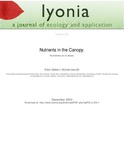Nutrientes en el dosel

View/
Date
2004-12Palabras Clave
nutrientes, epífitas, selva nublada, Andes, Venezuelanutrients, epiphytes, cloudforest
Metadata
Show full item recordAbstract
El objetivo de este estudio es esclarecer el rol de las epifitas en los flujos de nutrientes en el dosel de una selva nublada en los Andes Venezolanos. Las parcelas se encuentran entre 2300-2800 m en el Parque Nacional Sierra Nevada en el estado de Mérida, Venezuela. Se analizó el agua de la
precipitación incidente, neblina, deposición seca (entradas) hojarasca del dosel, y tejido de epifitas, agua retenida en Bromeliáceas (almacenados), y experimentos de lavado con epifitas y sin epifitas
para determinar el presupuesto y la dinámica de nutrientes en este sistema. Los análisis químicos para determinar las concentraciones de los macronutrientes fueron los siguientes: Nitrógeno
(método micro-Kjeldahl), Fósforo (método Colorimétrico) y Magnesio, Calcio y Potasio
(Espectrofotometría de absorción atómica). Se estimó la biomasa epifitita lo cual a su vez permite estimar las cantidades de nutrientes retenidos en el dosel. Las entradas vía neblina y precipitación
incidente al sistema en kg ha-1año-1 son de, N 33,66, PO4 5,13 K 12,67, Ca 33,14 y Mg 1,96. Los experimentos de lavado de ramas con epifitas y otros con follaje permitieron el estimado de cuánto esta saliendo o que ocurre con estos nutrientes en el proceso del pasar por el dosel. En el caso de K
y Mg sale mas del dosel que lo que entra por ende el dosel aporta a la parte inferior del ecosistema 51% y 62% respectivamente.Sin embargo, la cantidad total en % de entrada es de: N 77, PO4 64 Ca 37 y lo cual queda retenida en las comunidades en el dosel. Al determinar los rangos de macronutrientes en tejido vegetal de las epifitas; se halló, en % del peso seco, lo siguiente: N 0,5-1,37 Mg 0,1-0,2 K 0,4-1,6 Ca 0,2-0,85. Biomasa epifítica en este bosque es una de las más alta reportada en el mundo con 11,845 kg/ha-1.Los resultados de la materia orgánica en comunidades epifitas en el dosel resultaron con N 8,1%, Ca 9, PO4 14, Mg 0,2% K 0,2 y agua en las Bromeliáceas
los resultados de agua retenida fue de Ca 5,07mg/L, K 3,6 mg/L, N 1,4 mg/L, Mg 1,2 mg/L, PO4 ,33 mg/L. Los resultados identifican las comunidades epifitas como reservorio o sumidero de nutrientes
en este ecosistema.
Collections
Información Adicional
| Otros Títulos | Nutrients in the canopy |
| Correo Electrónico | ataroff@ula.ve rwalker@sg.inter.edu |
| Editor | Lyonia. A journal of ecology and application. Volume 7 (2) - 2004 |
| Resumen en otro Idioma | The objective of this study is to clarify the role of epiphytes in the nutrient fluxes of an Andean cloud forest in Venezuela. The plots are at 2300 to 2800 meter above sea level in the Sierra Nevada National Park in the state of Merida. The waters from incident precipitation and fog (inputs) the leaf litter, epiphytes plant tissue, and water in the Bromeliaceas (stored) and experiment simulating throughfall were analyzed to determine the nutrient budget and dynamics within the system. The chemical analysis to determine concentrations of macronutrients were the following: Nitrogen with the Kjeldahl Method, the Colorimetric Method for Phosphorous, and Spectrometry of Atomic Absorption for the Magnesium, Calcium and Potassium. The epiphyte biomass was calculated which in turn allows for the estimate of the amount of nutrients stored in the canopy. The inputs via fog and incident precipitation to the system are the in kg/ha/yr-1 is, Ca 33.14, N 33.66, K 12.67, PO4 5.13 y Mg 1.96. The experiments of throughfall with branches with leaves and others with epiphyte communities allowed for the estimate of how much of the incoming nutrients are leaving the canopy or explaining what is occurring with these nutrients as they go through the canopy. In the case of K and Mg more leaves the canopy than the atmospheric input therefore the canopy supplies the lower part of the system 51% and 62% respectively. However, the total amount of the incoming N 77, Ca 37 y PO4 64 % is stored or retained in the canopy. In determining the range of macronutrients in plant tissue the results are as follows: N 0.5-1.37 Mg 0.1-0.2 K 0.4-1.6 Ca 0.2-0.85 % of the dry weight. Epiphytic biomass in this forest is one of the highest recorded in the world with 11,845 kg/ha-1. The organic material was collected in the canopy had N 8.1%, Ca 9, PO4 14, Mg 0.2%, K 0.2. and the water stored in Bromeliaceas had Ca 5.07mg/L, K 3.6 mg/L, N 1.4 mg/L, Mg 1.2 mg/L, PO4, 33 mg/L. The results identify the epiphytic community as a pool or sink of nutrients within the ecosystem. |
| Colación | 7-14 |





